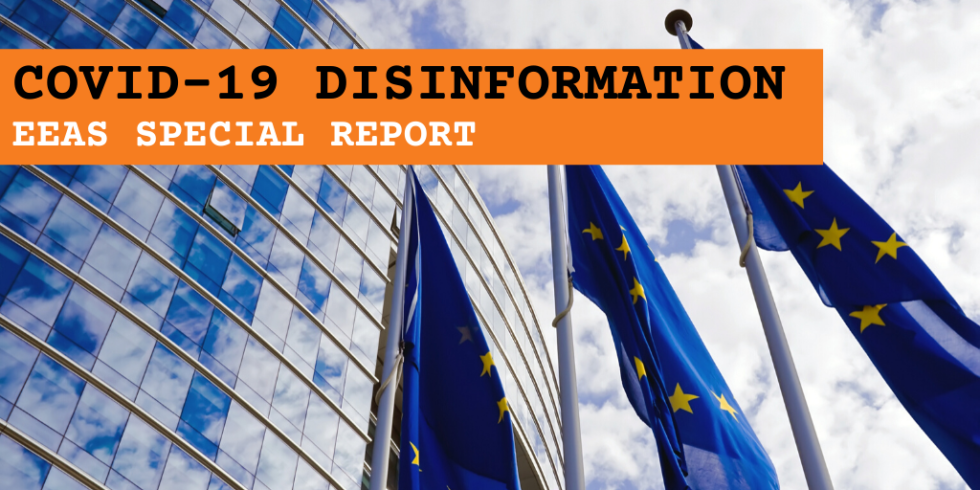
Note: The objective of this report is to provide a snapshot overview of the current trends and insights into disinformation activities related to COVID-19. It does not provide a comprehensive or complete overview and focusses primarily on the external dimension, in line with the EEAS mandate. The report was authored by the EEAS Strategic Communications and Information Analysis Division, which contributes to the EU’s efforts to counter disinformation, including through detection, analysis and exposure of disinformation campaigns. In addressing disinformation and identifying and analysing disinformation surrounding the COVID-19 outbreak, the EEAS is working closely with the European Commission and EU Member States. The EEAS also cooperates on this issue with international partners (G7, NATO and non-state actors). The results are regularly published on EUvsDisinfo.eu and social media channels. Insights are shared with EU institutions and EU Member States in real time, including through the Rapid Alert System on Disinformation.
With the outbreak of COVID-19, we have seen the proliferation of significant quantities of news, myths, and disinformation about it – coming from various sources both within and outside of the European Union. The World Health Organisation has stated that the outbreak of and response to COVID-19 has been accompanied by a massive “infodemic”, which the WHO describes as an over-abundance of information – some accurate and some not – rendering it difficult to find trustworthy sources of information and reliable guidance.
Today, the information environment around the coronavirus is characterised by an immense amount of content from different sources and on different media. Governments and health authorities are trying to provide authoritative information about COVID-19 and social media platforms are looking for effective ways to promote this content, while simultaneously demoting or removing unreliable content. At the same time, we are witnessing a substantive amount of both misinformation and disinformation spreading on- and offline. While misinformation involves the unintentional spread of false information, disinformation campaigns entail the intentional production and/or dissemination of verifiably false content, spread either for political or financial reasons.
Overview of currently trending false narratives:
- The coronavirus is a biological weapon deployed alternatively by China, the US, the UK or even Russia (with the aim of destroying the EU and NATO)
- The coronavirus did not break out in Wuhan, China – the US is concealing its true origin, which is in fact the US or US-owned laboratories across the world
- The outbreak has been caused by migrants and migrants are spreading the virus in the EU
- The coronavirus is linked to 5G (e.g., Wuhan as a 5G testing ground)
- The EU has failed to handle the crisis – the EU is a disaster for Europe
- The EU is not ready to provide urgent support to its Member States – instead, they have to rely on external support (e.g., Italy), with China mentioned most often as the source of such assistance
- China is coming to rescue the EU as Brussels abandons EU Member States
- Schengen no longer exists – Europeans are in quarantine, but migrants can move freely
- The coronavirus is a hoax, it does not exist
- The EU could impose mass vaccinations
- Cures: claims that natural remedies exist to cure the virus, which are often combined with anti-vaccination narratives
- Miscellaneous conspiracy theories: historical predictions about the pandemic, plagues hitting the planet, secret “Deep State” attempts to control population growth, the pandemic being caused by chemtrails or leading to World War III
Pro-Kremlin disinformation
The coronavirus is a relentless and daily topic in pro-Kremlin media, including state-owned outlets. As of 19 March, the East StratCom Task Force has collected over 110 corona-related disinformation cases in the public EUvsDisinfo database since 22 January 2020. These messages are characteristic of the Kremlin’s well-established strategy of using disinformation to amplify divisions, sow distrust and chaos, and exacerbate crisis situations and issues of public concern.
According to Buzzsumo, an online analytical tool that allows users to find out what content is popular by topic or on any website, RT Spanish persistently remains among the top-20 most engaged with sources online (on Twitter, Facebook and Reddit) when it comes to coronavirus-related information, ranking as high as the 12th most popular domain
There are also notable differences in the Kremlin’s disinformation strategies vis-à-vis domestic and international audiences:
- Messages targeting domestic Russian audiences describe the virus as a form of foreign aggression, for instance claiming that the coronavirus originates in secret US or Western laboratories and emphasising that challenges coping with the virus mainly affect foreign and democratic countries, while Russia is fighting the outbreak
- Messages targeting international audiences (in English, Italian, Spanish and Arabic, among other languages) follow a different approach: they focus primarily on conspiracy theories about “global elites” deliberately weaponising or exploiting the virus for their own ends. Here the aim is to induce distrust in national and European authorities and healthcare systems, international institutions, and scientific experts, among others.
- Narratives describing the virus as man-made is present in disinformation targeting all audiences.
Coverage related to the MENA region
In the MENA region, the outbreak has been used by authorities, terrorist organisations, and prominent influencers to advance geopolitical agendas:
- Daesh has been exploiting the trending hashtags (including ones on the coronavirus) to spread their own messages for their own purposes.
- The coronavirus has been used to foment hate speech and fuel the Sunni-Shia confrontation in the region.
- The outbreak has also been used (i) against Iran to spread anti-Iran sentiments, claiming that the coronavirus is an aggressive attack by Iran that turned the virus into a political tool, and (ii) from Iran, claiming that the virus may be a biological weapon from the US.
Coverage related to the Western Balkans region
False news, misinformation, and disinformation concerning COVID-19 were also observed in the Western Balkans information environment. Narratives such as “The virus was developed in a lab to target China and Iran” were visible in media across the region. There are several risks attached to the spread of corona-related disinformation in the Western Balkans:
- It may be weaponised in ongoing electoral debates and to discredit opponents with conspiracy theories, for example in the context of upcoming elections in Serbia and North Macedonia.
- It may be weaponised against migrants.
- It may be used by foreign sources to manipulate local information spaces.
Coverage related to China
Public coverage related to the coronavirus and China includes the issue of censorship by the Chinese Communist Party and the aim of the party to present itself as strong and successful in face of the pandemic. Chinese platforms YY and WeChat also seem to have automatically censored posts critical of the Chinese government. Some of the main pro-Chinese narratives include the following:
- China and especially Xi Jinping have done an admirable job of containing the coronavirus; a centralised state such as China’s is actually an asset in such a crisis because the processes (and citizens) can be more thoroughly controlled.
- The West, and especially the United States, should be grateful to China for their quick reaction and containment of the virus – the West and especially the US worked too slowly and are now in total disarray over the virus.
- The virus did not originate in China, it stems from somewhere else (most likely the US).
- The West instrumentalised the virus in order to harm China and spread anti-Chinese sentiment, for which it owes China and the Chinese people an apology.
Actions taken by social media platforms
Social media companies are also working on ways to tackle the spread of mis- and disinformation around the coronavirus on their platforms. Overall, Google, Facebook, Twitter, and Microsoft have declared that they are working with national health authorities as well as the World Health Organisation to promote authoritative content and make it more accessible to users (such as via Google’s SOS alert). On 16 March, Facebook, Google, LinkedIn, Microsoft, Reddit, Twitter and YouTube issued a joint statement announcing that they are working closely together during this time.
Different platforms are taking different steps, such as the deletion of false content, giving ad space to public health authorities, and removing apps connected to COVID-19, e.g. from Google PlayStore. Twitter for example announced that it will broaden its definition of “harm” to content that goes directly against advice by trusted sources such as national health authorities, including descriptions of treatments or cures that are harmful or ineffective. Facebook provides a collection of authenticated information from health authorities, e.g. for community managers as well as information on tools that might help moderate conversations in communities (such as how to block comments). Facebook also announced their “Coronavirus (COVID-19) Information Center, featured at the top of News Feed, to provide a central place for people to get the latest news and information as well as resources and tips to stay healthy and support their family and community”, which includes real-time updates by health authorities. The company also announced increased funding for the International Fact-Checking Network (IFCN). Reddit also published information on how it aims to deal with coronavirus-related misinformation, not only by providing expert conversations on the topic, but also potentially taking the measure of applying “a quarantine to communities that contains hoax or misinformation content”. Additionally, platforms seek to ban ads related to the virus or ads seeking to profit off COVID-19.
However, despite their publicly announced measures, evidence indicates that platforms are continuing to host false and harmful ads that for example propagate “numerical codes” as a cure for COVID-19 or misrepresent quarantine as the first step in imposing NATO rule over Europe. This suggests that platforms have difficulties adhering to their own published standards and public commitments on preventing the proliferation of dangerous coronavirus-related disinformation, despite allocating significant resources to this task. As a result, this raises concerns that the problem is not merely the prevalence of harmful speech online but rather a system of broken incentives which prevents internet platforms from adequately protecting the public interest. Moreover, the scope, impact, and success of the actions that platforms are taking is hard to assess independently, especially considering the restrictions on privacy-compliant access to public interest data for researchers.




